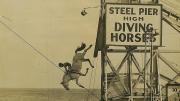For a first book, it has quite a title. The Fires: How A Computer Formula, Big Ideas, and the Best of Intentions Burned Down New York City—and Determined the Future of Cities is the story of how, in the 1970s, New York’s struggling leaders hired the RAND corporation, a military think tank, to apply its computer modeling system to city management, with disastrous results. Joe Flood ’04 tells how the city's use of sophisticated, mathematical models developed by RAND led it to withdraw fire protection from some neighborhoods—and led to thousands of deaths and the loss of roughly 600,000 homes. (The Wall Street Journal also reviewed The Fires, and the Atlantic ran an interview with Flood on city management.)
The origins of Flood’s interest in the story go back to his undergraduate days. His journalism career began, not surprisingly, at the Crimson—“when people ask me what I majored in at Harvard I usually say ‘the newspaper.’” During summers, he wrote for professor of psychiatry and medical humanities emeritus Robert Coles’s now-defunct Doubletake magazine, and worked at a soup kitchen called the Catholic Worker, on New York's Lower East Side. He became interested in local history, and particularly in how the area had changed from an upwardly mobile immigrant neighborhood to a slum marked by a “more entrenched kind of poverty, with high rates of crime, drugs and dysfunction.” It wasn’t long before he began noticing clues to something shadowy and anomalous that had happened in the ’70s: “I talked to a lot of longtime locals and they told me about when the neighborhood was burning down… ‘Burning down?!’ I thought—it just didn’t compute for me, a modern city burning down like nineteenth-century Chicago? But eventually I ran the census numbers and sure enough the Lower East Side lost a massive percentage of its housing stock and population to fires during the 1970s.”
(Those fires also led to a tuberculosis outbreak in New York City. A 2008 Harvard Magazine feature article on TB describes how the "vast internal migration" away from the fire-ravaged neighborhoods led to overcrowding—and the spread of infection—in adjacent neighborhoods, sparking an outbreak that lasted until the 1990s.)
Intrigued, Flood began investigating in his free time once back in Cambridge. After graduating, he took a job teaching high school on the Pine Ridge Indian Reservation in South Dakota, but after two years, he moved to New York to research the story full time. He was lucky enough to find an initial helper in Sam Hornblower ’02 (currently an associate producer for 60 Minutes), “one of the most dogged researchers I’ve ever met.” Though he focused on the fire department’s library, he also combed through city archives and read books on urban planning, economics, and computer modeling. But the bulk of the work was interviews: with retired firefighters, politicians, policy wonks, and people from the affected neighborhoods—the Bronx, Harlem, the Lower East Side, and Brooklyn. Finally, he visited the RAND archives in Santa Monica, California.
Flood believes that his story teaches many lessons about the mistakes of “well-intentioned people in power,” particularly mistakes caused by over-reliance on mathematical systems. “The problem is that, after that first wave of success, people become dogmatic about the power of numbers, and the models go from being a new way to think harder about complicated problems to a justification for not thinking,” he says. Ironically, chapter four, “Of Whiz Kids and Think Tanks,” opens with a quotation from the late RAND academic John von Neumann that perfectly encapsulates this notion: “If people do not believe that mathematics is simple, it is only because they do not realize how complicated life is.” The apparent infallibility of numbers, and of systems built upon numbers, leads to overconfidence, Flood believes, and this in turn creates a recurring pattern of error. “History is one big, long tale of mistakes and misconceptions, and I don’t see that changing any time soon.”







